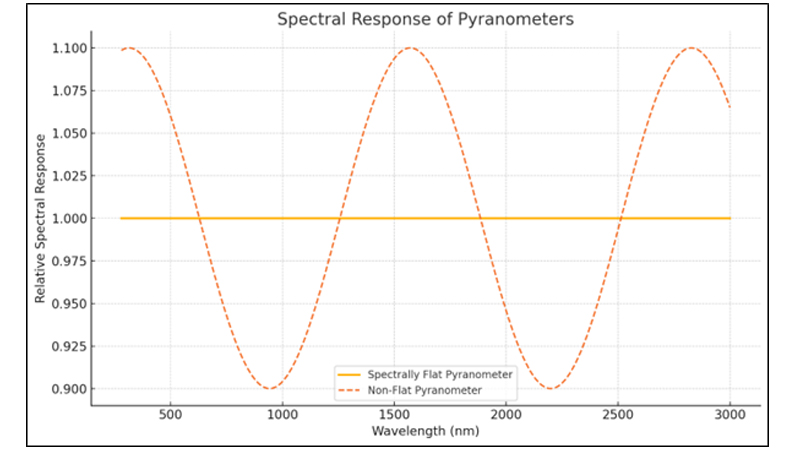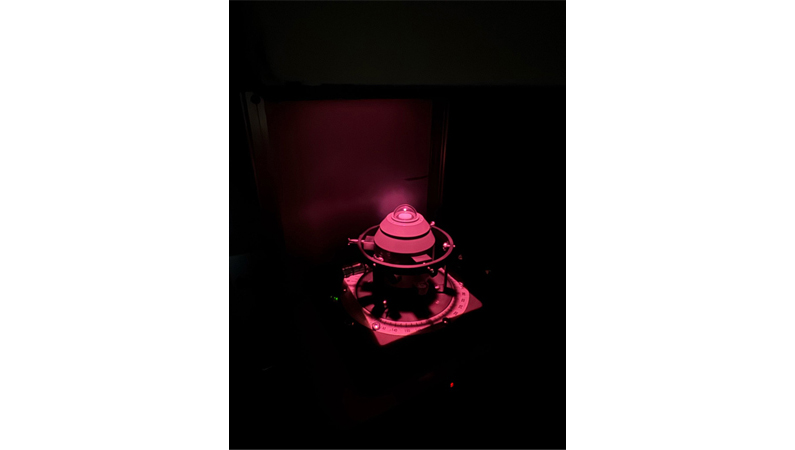Our SEVEN 3S-TP-MB-A Thermopile Pyranometer is introduced and referenced in all documentation with the phrase: “ISO 9060:2018, fast response, spectrally flat, and Class A”. But what exactly does “spectrally flat” mean? This article examines the term “Spectrally Flat”, which we frequently encounter in thermopile pyranometer classifications, according to the ISO 9901:2021 standard.
Among the classification requirements for thermopile pyranometers is the spectrally flat parameter. Spectrally flat pyranometers are devices that provide a stable and linear response to incoming solar radiation over a specific spectral range (typically 280 nm to 3000 nm). This means the device’s response should not vary depending on the wavelength of the radiation it measures.
According to ISO 9901:2021:
“” ISO 9060 categorizes pyranometers not only into accuracy classes (A, B, and C), but also based on two main types and an additional subclass:
- Spectrally flat pyranometers – most thermoelectric (thermopile) pyranometers fall into this category.
- Spectrally non-flat pyranometers – photodiode (silicon) pyranometers may fall into this category.
A separate subclass for fast-response pyranometers is also defined
Table 1 — Application of pyranometers of different ISO 9060 accuracy classes for the most common solar energy studies

Pyranometers classified in ISO 9060 as “spectrally flat” have a spectral selectivity of less than 3 % (guard bands 2 %) in the 0,35 μm to 1,5 μm spectral range. This is the same requirement as in the previous ISO 9060:1990 for secondary standard pyranometers. Spectrally flat pyranometers are typically more accurate over a wide range of conditions, and applicable not only for horizontal measurement of global horizontal irradiance, GHI, but also for measurements of plane of array irradiance, POA, and reflected irradiance, RI, as well as for artificial solar sources such as lamps. IEC 61724-1 requires use of instruments of a specified accuracy class for its class A and B Monitoring systems.
There is consensus that the spectral selectivity specifications of ISO 9060 “spectrally flat” pyranometers have a negligible (zero) spectral error and that they can be used for all the common outdoor measurements in solar energy studies with the same calibration (typically performed with the clear sky solar spectrum as the source) without significant loss of accuracy. The clear sky solar spectrum is one of the reference operating conditions for pyranometers if it is the source under which an instrument is calibrated or the source under which a calibration reference standard has been calibrated.
Pyranometers employing photodiodes (otherwise known as silicon-pyranometers), are not classified as “spectrally flat” in ISO 9060. The spectral error of pyranometers is defined for a set of clear sky solar spectra only. This implies that their spectral error for other than clear sky spectra cannot be based on the classification alone. The spectral error of pyranometers, in particular if they are not spectrally flat, may be larger for measurements of DHI, POA or RI than for clear sky GHI. The user may perform an individual uncertainty evaluation depending on the manufacturer specification of the instrument and the spectra of the measured radiation. The factory calibration of non spectrally flat instruments is typically valid for a set of clear sky solar spectra. Their sensitivity and uncertainty of their sensitivity may both change for different conditions.
Spectrally flat pyranometers can be used for the most common solar testing applications, including GHI, POA, RI and albedo measurements using traceability to the same clear sky spectrum calibration. When using non-spectrally flat pyranometers for other than clear-sky GHI measurements, the spectral error may be larger than the spectral error specified in ISO 9060. “”
To determine whether a pyranometer is spectrally flat, its spectral response function is analyzed. Ideally, the spectral response curve should be as flat as possible. If the instrument is more or less sensitive at specific wavelengths, it cannot be considered spectrally flat.

In conclusion, the ISO 9901:2021, ISO 9060:2021, and IEC 61724:2021 standards recommend the use of spectrally flat pyranometers to ensure accurate and reliable measurements in solar energy systems. These pyranometers provide high accuracy in solar irradiance measurements thanks to their stable response across a wide spectral range. The use of spectrally flat pyranometers is a critical requirement for photovoltaic system performance analysis, energy efficiency assessments, and long-term investment calculations.
To explore and learn more about our SEVEN 3S-TP-MB-A “ISO 9060:2018, fast response, spectrally flat, and Class A” Thermopile Pyranometer, please visit:
https://www.sevensensor.com/pyranometers
